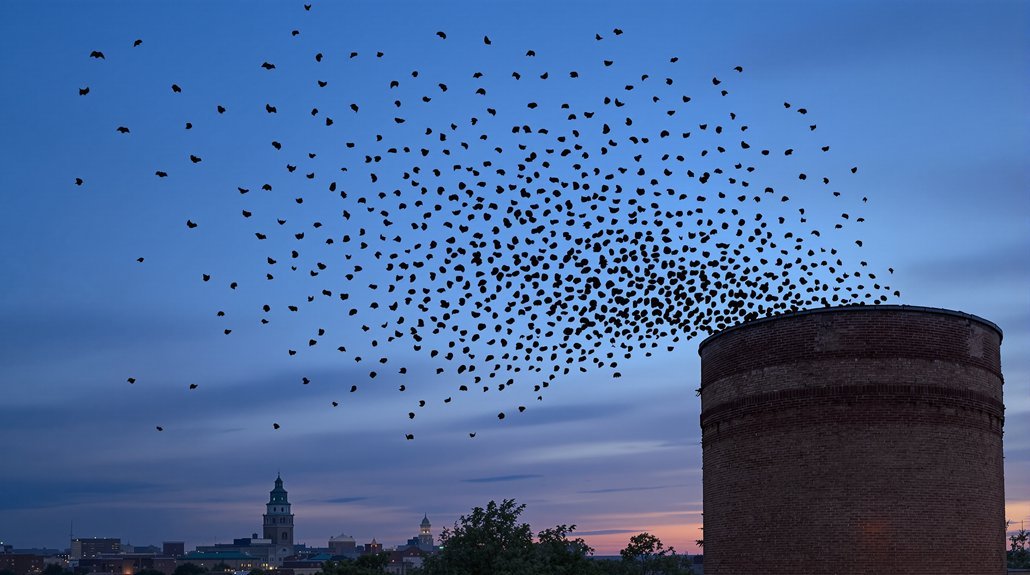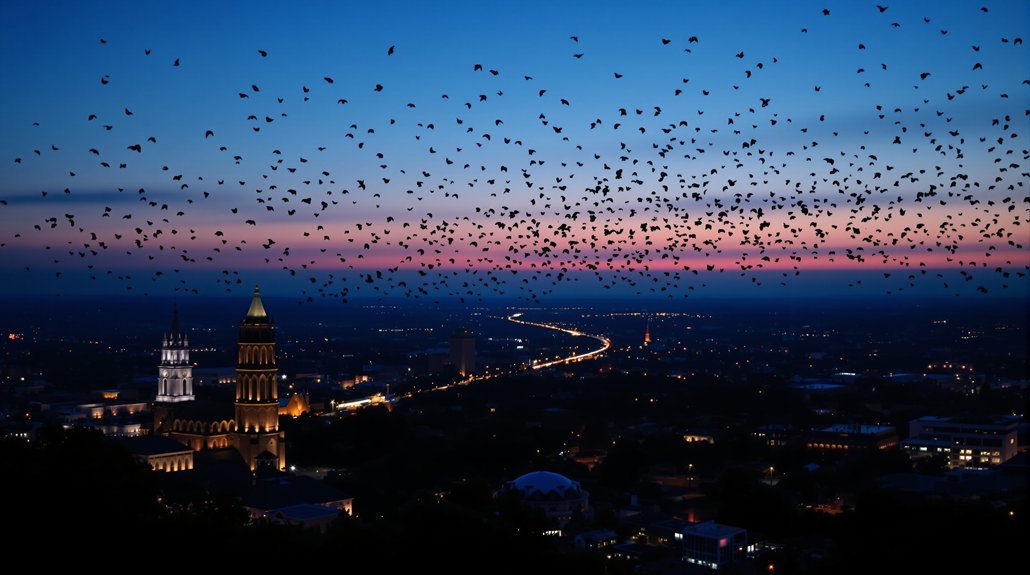Bats in Des Moines, Iowa, are most active during dusk and early evening. They typically emerge from their roosts around sunset to forage for insects. Their activity peaks between 7 PM and 9 PM, as temperatures cool and insect populations are high. Bats also tend to fly lower and zigzag while hunting during this time. Observers can enjoy watching these nighttime creatures in areas near water sources, which attract plenty of insects. There is much more to learn about bats and their behavior.
Key Article Highlights
- Bats in Des Moines are most active at dusk, shortly after sunset, as they emerge from roosts.
- Early evening (7 PM – 9 PM) sees bats actively foraging for insects.
- Midnight can be a peak activity time as temperatures cool, enhancing foraging efficiency.
- Pre-dawn hours, just before sunrise, are when bats make their last foraging rounds.
- Seasonal variations affect activity, with spring emergence marking increased activity at dusk.
Understanding Bat Behavior

Although bats are often misunderstood, their behavior is quite fascinating. They are known for their unique roosting sites, which can include caves, trees, and man-made structures. These locations provide safety and a place to rest during the day. Bats are nocturnal creatures, relying on echolocation techniques to navigate and hunt for food in the dark. By emitting high-frequency sounds, they can detect objects and prey around them. This ability helps them avoid obstacles and locate insects with precision. Understanding these behaviors reveals the complexity of bats and their important role in the ecosystem. As they adapt to their environments, their roosting habits and echolocation skills showcase their remarkable survival strategies. Echolocation is especially crucial for their nighttime activities and efficient insect hunting. Additionally, their activity patterns are closely tied to dusk, when they emerge to forage for insects, making late evening the peak time for bat activity.
Peak Activity Times for Bats

As night falls, bats in Des Moines, Iowa, become most active, taking advantage of the darkness to hunt and forage. Their peak activity times typically occur during the following hours:
- Dusk (around sunset): Bats emerge from roosts, using bat echolocation to locate their prey.
- Early Evening (7 PM – 9 PM): Nocturnal foraging begins in earnest, as insects are plentiful.
- Midnight (12 AM): Activity may peak again as bats continue to hunt in cooler air.
- Pre-Dawn (before sunrise): Bats make final foraging rounds, using echolocation to navigate before returning to roost.
These times reflect the bats’ reliance on darkness for their survival and efficient feeding strategies.
Seasonal Variations in Bat Activity

Seasonal variations play a significant role in bat activity in Des Moines, Iowa. In spring, bats emerge from hibernation and begin to search for food. During summer, they focus on feeding, while in winter, they typically roost and conserve energy.
Spring Emergence Patterns
Spring marks a significant shift in bat activity in Des Moines, Iowa. As temperatures rise, bats emerge from their winter roosts, leading to increased activity. This season is crucial for bat hunting and cave exploration. During spring, bats prepare for the warmer months, and their behavior becomes more noticeable.
- Bats leave hibernation sites in search of food.
- They begin to hunt for insects at dusk.
- Males establish territories and engage in mating displays.
- Bats explore caves for suitable roosting sites.
These patterns highlight the passage from dormancy to increased foraging and reproductive activities. Understanding these spring emergence patterns is essential for studying local bat populations and their ecological roles.
Summer Feeding Habits
With the arrival of summer, bat activity in Des Moines shifts markedly. During this season, various bat species become more active as they seek food. They primarily hunt for insects, which are abundant in warm weather. Bats often change their flight patterns to maximize their feeding efficiency. They may fly lower to the ground, zigzagging to catch insects, or soar higher to spot larger swarms. This increased activity typically occurs during dusk and dawn when insects are most active. As the summer progresses, bats adapt their foraging behavior to the availability of food sources. Understanding these feeding habits helps researchers and enthusiasts appreciate the ecological role bats play in controlling insect populations in urban areas like Des Moines.
Winter Roosting Behavior
During winter, bats in Des Moines exhibit distinct roosting behaviors as they adapt to the colder temperatures and reduced food availability. Many species engage in bat migration, traveling to warmer areas where insects are more plentiful. For those that remain, they seek sheltered roosting sites to survive the harsh conditions.
Here are some key aspects of their winter roosting behavior:
- Hibernation: Bats enter a state of dormancy to conserve energy.
- Sheltered Locations: They choose caves, attics, or tree hollows for protection.
- Group Roosting: Bats often roost in groups for warmth and safety.
- Reduced Activity: They limit movement to conserve energy until spring returns.
Best Locations for Bat Watching
Finding the best locations for bat watching in Des Moines, Iowa, can enhance the experience of observing these fascinating creatures. Ideal spots include parks and natural areas near water sources, as bats often gather there during their migration. Urban bat habitats, such as bridges and buildings, also serve as excellent viewing points. Observers may find bats emerging from these locations at dusk, providing a spectacular sight. Popular areas include Gray’s Lake Park and the Des Moines River, where bat activity is high. Additionally, local wildlife reserves can offer guided bat watching events, ensuring a more educational experience. By choosing the right locations, bat watchers can enjoy a unique opportunity to witness the beauty of bat migration and urban habitats.
Tips for Observing Bats Effectively
Although observing bats can be an exciting experience, effective techniques can enhance the enjoyment. To observe bats in Des Moines, enthusiasts should consider the following tips:
Observing bats can be thrilling; employing effective techniques enhances the overall experience for enthusiasts.
- Choose the Right Time: Visit during dusk when bats emerge to hunt, taking advantage of their nocturnal adaptations.
- Use Quiet Equipment: Bring binoculars or a camera with a zoom lens to avoid disturbing the bats, promoting bat conservation.
- Find a Suitable Spot: Select locations near water sources or open fields where insects are abundant, attracting bats.
- Be Patient: Wait quietly and watch for movement in the sky. Bats may take time to appear, but persistence rewards observers with an unforgettable sight.
These strategies can lead to a more rewarding bat-watching experience.
The Importance of Bats in the Ecosystem
Bats play a vital role in maintaining ecological balance. They are essential for insect control, consuming vast quantities of insects each night. This natural pest management helps farmers and reduces the need for chemical pesticides. Bats utilize bat echolocation to navigate and hunt for food in the dark, allowing them to locate and capture insects with great precision. By keeping insect populations in check, bats contribute to healthier crops and gardens. Moreover, they aid in pollination and seed dispersal, benefiting various plant species. The presence of bats in an ecosystem indicates a healthy environment. Their decline could lead to increased pests and disrupted ecosystems, highlighting their importance in maintaining biodiversity and ecological stability.

